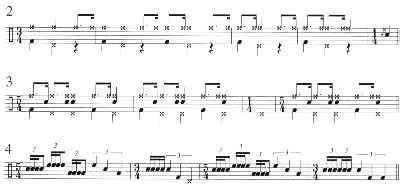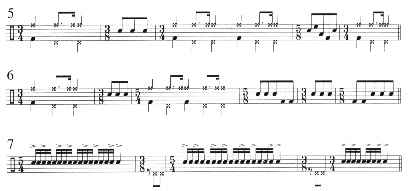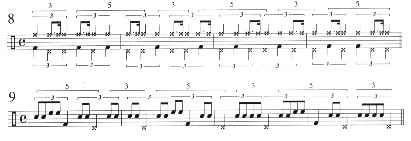Welcome to PaulWertico.com!
Creative Fours
The concept of trading fours is a time-honored tradition in jazz. Through the years, though, I've encountered a number of students who have experienced a creative roadblock when attempting them. This occurs mostly to those drummers who are inexperienced in playing jazz. Since a lot of them have played rock and pop most of their lives, the idea of trading fours seems a bit foreign. Also, because of playing rock and pop, some of them have become used to playing fills and phrases that begin and/or end on the "1", so the idea of "breaking up the time" can be somewhat challenging.
As a result, when these drummers trade fours, they often string together a bunch of familar licks or patterns in a very "unjazz-like" way. However, after first learning some of the more traditional and musical approaches to exchanging fours - such as playing things that open up a musical dialogue with whomever they're exchanging fours, or playing something that relates to the melody - their playing begins to "open up". But there are even more adventurous approaches that can really extend a drummer's ability to play creative fours.
When you listen to some jazz drumming masters, such as Roy Haynes, you might notice how their fours seem to break up time in very interesting - and sometimes almost baffling - ways. To the novice jazz listener, it almost seems that these drummers are playing in a random or free-form manner. However, when you analyze these "out" sounding fours, it becomes clear that the masters know exactly what they're doing. They just break up the time in very creative and sometimes asymmetrical ways. It's with this in mind that I have compiled a few techniques in order to look at fours in a different light.
If you imagine four bars of 4/4 as being comprised of sixteen beats, with some creative thinking you can break up these sixteen beats into various blocks or counter-time signatures. Take a look at example 1A. Here, instead of four bars of 4/4 time, we have two bars of 3/4 and two bars of 5/4. The result is still sixteen beats, but subdivided in a mixed-meter type of way. This changes the flow of the time and also allows you to know where you are without guessing.

Examples 2, 3, and 4 are more ways to "break up" the time using mixed meters.

When practicing these techniques, play four bars of straight 4/4 time, then play an example, then play four bars of straight 4/4 time again, and so on. Start out simply, playing just bass drum, hi-hat, and ride cymbal. Make sure you count the meter changes and subdivide accurately. Use a metronome. Eventually, you'll get used to hearing and feeling the meter changes. Try to make everything sound natural, not stiff or contrived. This technique is also more effective when the time signature changes are clear to the listener. Later, as you get comfortable, you can get more and more adventurous by adding various drums and different rhythms, as well as accents and dynamics, within the time signature changes.
I would also suggest that you practice giving a clear and solid downbeat on the "1" of the first 4/4 bar after your exercise. This will help later when you try playing these kinds of fours with a band. By giving a clear and solid downbeat on the "1" after your four, you will help solidify the band's re-entry. (These types of fours are supposed to inspire your bandmates, not trip them up or completely lose them!)
As a variation to this approach, I also recommend that you try to play these exercises not as mixed meter groupings, but as odd phrases over straight 4/4. Feel and hear 4/4 time and play the odd groupings as superimpositions over four bars of four. See example 1B. It's identical to example 1A, except that here you think of four bars of 4/4 time grouped in three's and five's. This will strengthen your ability to play odd phrases in 4/4 time.

Now, let's look at breaking up those sixteen beats in the four bars of 4/4 using 8th-note subdivisions. (This results in a total of thirty-two sub-beats.)
Look at examples 5, 6, and 7. Here we add some 3/8 and 5/8 bars to the rhythmic equation. In doing this, we can displace the 3/4 and 5/4 bars by an 8th note. This makes a normal rhythmic figure seem displaced, as in example 5. The effect can really make things sound "backed-up". Again, when you try out all these examples, be sure to count, subdivide accurately, and use a metronome.

Next let's look at this technique utilized in a polyrhythmic way that also implies mixed meters. Look at examples 8 and 9. In these examples, a similar approach is used, but in a "six over four" manner. Here, the total number of "poly-beats" (made up of quarter note triplets) in four 4/4 bars is twenty four. You can group the quarter-note triplets any way you want to, as long as they they total twenty-four.

You can expand this approach ad infinitum, applying this concept to trading 8ths and 16ths, playing fours in various time signatures, using five quarter notes over four, and so on. These techniques should help not only expand your concept of fours, but of time in general. It should also help you to know where you are in the flow of time during those times when you decide to "go for it". However, when you try these techniques out, make sure to use musical discretion. Always be sure that the other musicians you're playing with are capable of following what you're doing and that the fours you play fit the type of music you're playing. (I don't think that playing these type of fours while doing a traditional Dixieland gig would fit all that well!)
Also, there's nothing worse than when a drummer throws off the entire band, or when everyone on the dance floor stops and looks up at the bandstand in bewilderment and disgust. Remember, even if what you play is in time, if the end result is a train wreck, then there'll no doubt be some bad feelings. And you certainly don't want to jeopardize the music (and maybe even your gig) in the pursuit of some hip-sounding four that everyone else needs a pocket calculator to figure out.
However, if your fellow bandmates are talented and open to new ideas, then this type of approach might not only open up your playing, but maybe their playing (and composing) as well. Have fun, and don't hurt yourself!
Images and Information from Modern Drummer October 1999, pages 112-114